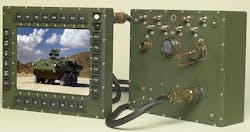Army looking for COTS dumb terminals to upgrade obsolescent rugged displays in DVH A1 Stryker vetronics
Officials of the Army Contracting Command in Warren, Mich., issued a request for information (W56HZV-19-Vehicle-Electronics-and-Architecture-Request-for-Information) last week to find commercial off-the-shelf (COTS) solutions for DVH A1 in-vehicle network-2 (IVN-2) mission display.
The Army Contracting Command is issuing this RFI on behalf of the Vehicle Electronics and Architecture office of the Army Tank and Automotive Research, Development, and Engineering Center (TARDEC) in Warren, Mich.
Army vetronics designers are looking for stand-alone dumb displays to replace the Stryker DVH A1 video display terminal (VDT) and its replacement video display electronic terminal (VDET), which rapidly are approaching obsolescence, Army officials say.
Related: Rugged high-brightness displays for ground vehicles and helicopters introduced by Esterline
The new display's USB touchscreen and USB bezel may be provided to the keyboard, video, mouse (KVM) through one interface, and the displays should be able to accommodate secure classification separation. The new display's performance should be equal to or better than the current VDET specification.
The rugged displays must have active touchscreen areas of at least 10 inches. The complete display and bezel must not be larger than 12.25 by 11 by 4.25” inches, and weigh no more than 24 pounds. Its bezel buttons must use the USB human interface device (HID) keyboard protocol, and use either the USB HID touchscreen; USB HID touchpad; or USB HID mouse protocol.
If companies interested would like to suggest a smart display is suggested, its processor must be physically removable from the unit at its point of manufacture so that the Army would not need to remove the processor later on.
The display’s required interfaces are summarized below. In your RFI response, please indicate if the display has been tested against TEMPEST requirements (Type 1, 2 or 3) and the results of any such testing.
Related: Rugged vetronics embedded computer and smart display offered by General Dynamics Canada
Army officials want to know the availability and cost of providing a display without an internal processor in a production quantity of 300 units per year; and risk areas that inhibit product development.
The only wants display hardware that meets the Stryker Mission Display (SMD) performance specification, which is available for download as a Microsoft Word document at https://www.fbo.gov/utils/view?id=cb6f4457b2ddb812eafe28dae2bee0ea.
Companies interested should email responses to the Army's Jenelle Vickberg at [email protected] no later than 18 Feb. 2019. Email questions or concerns to Vickberg at [email protected].
More information is online at https://www.fbo.gov/notices/ab233684b4f2e814712e1a15cf738afb.
Ready to make a purchase? Search the Military & Aerospace Electronics Buyer's Guide for companies, new products, press releases, and videos
